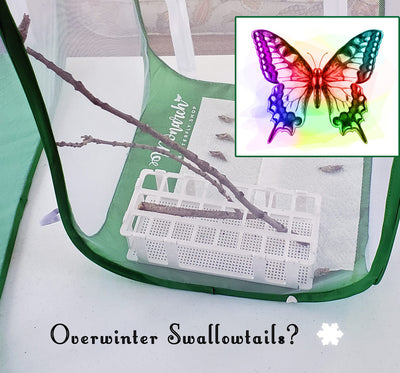Raising Butterflies Blog
How to Raise the Giant Swallowtail Butterfly through Life cycle

A Photo Journey Raising Giant Swallowtails from Egg through Butterhood
For five years straight, we were beyond excited to see the Giant Swallowtail Butterfly (Papilio cresphontes) gracing our northern garden.
So, a couple seasons ago we decided to see if we could entice GST females to drop off a few of their caterpillar kids…
We planted 3 potential host plants for giant swallowtails caterpillars: Ruta Graveolens (common rue), Ptelea trifoliata (wafer ash or hop tree) and Zanthoxylum americanum (northern prickly ash).
Unlike milkweed-obsessed monarchs, the giant swallowtail female will lay eggs on a wide range of host plants. Their butterfly life cycle also takes up to 2 months, so the odds are stacked against northern gardeners wanting to raise them with fewer generations and more plants to search!
The season after planting was the first time in years we saw zero giant swallowtail butterflies…had extending northern hospitality to a southern butterfly species been a waste of time?
The next season, we would have our answer...
note: If you’re interested in learning more about (or purchasing) giant swallowtail host plants, get more info on my butterfly host plants page
The Eggs
The eggs of the giant swallowtail are pretty easy to find compared to other butterfly species that resort to trickery and camouflage to keep their eggs safe.
The giant swallowtail female deposits orange-peel colored eggs on the surface of green leaves, which means you shouldn’t need to get out the old magnifying glass to confirm identity.
Brenda of Brenda’s Butterfly Habitat shared that Zanthoxylum americanum (northern prickly ash) was the giants’ host plant of choice in her Michigan garden.
A year after planting, we received all of our first giant swallowtail eggs on northern prickly ash

As easy as the eggs are to locate, they can still be easy to miss because prickly ash sometimes gets an orange fungus (pretreat with hydrogen peroxide), so perhaps the eggs are better camouflaged than it would appear!
If you are lucky enough to come across these tiny orange globes, use floral tubes to keep the host plant fresh until the caterpillar hatches and for up to a week after:

Find Floral Tubes for Keeping Host Plants Fresh Here
However, the eggs were not what I first noticed munching on the prickly tree leaves…
The Caterpillars
We found five caterpillars on our plants, before searching for and finding two eggs. Four of the caterpillars also had an orange hue:
while one of them was dark:

This could be a normal color variation or they could have been in different larval stages. (Unfortunately, we did not find them right away like with the tiger swallowtails we raised last season.)
We also made a fatal mistake with the two eggs we brought in. Whenever you bring in eggs of any butterfly species, make sure they’re properly protected from ravenous caterpillars 😢
As the caterpillars grow, they bear a striking resemblance to bird droppings…

…and snakes, which could ultimately help them avoid deadly confrontations with dangerous predators:

A third line of defense is the red horns (osmeterium) that emerge from the head of the caterpillar when it feels threatened. The osmeterium emits a pungent odor, that is supposed to make them unpalatable to predators, like ants.
I stroked one across its back, and picked up another that was looking for a fresh cutting…neither action was enough for them to ‘Release The Red Cracken’.
Did you notice the dangerous thorn next to the back of the caterpillar photos above? I was going to offer the caterpillars our rue plants without the thorny barriers, but decided to try serving this because I need to cut it back to avoid getting gouged when mowing the back yard.
Here’s how it works:

- Cut stems off the plant (about 12 inches) with a hand pruner that will fit inside a floral tube or other cutting container. Before you grab the stem, look for thorns
- Go over to a yard waste can and cut off the thorns on the part of the stem that will be submerged in water
- Put the cuttings inside the caterpillar cage.
- If you’re replacing cuttings, set the new cutting container next to the old one so the caterpillars can crawl over to their new home and caterpillar food source.
Check out caterpillar cages, floral tubes, and other helpful raising tools on my Raising Resource Page
As the caterpillars grow, so do their appetites. However, they haven’t been as ravenous as munching monarch caterpillars. Even with 5 big caterpillars in close quarters, they peacefully coexist:

Once the Papilio cresphontes caterpillars have finished their feeding frenzy, they do what I imagine Joey chestnut did shortly after winning Nathan’s hot dog eating contest:

After they purge, many raisers worry about their restless behavior as they pace the cage seemingly unable to find a single spot suitable to form a chrysalis:

There’s no need to worry, because eventually they will make a pupation decision, and when they do…
They’ll climb up a plant, cuttings container, or the side of your butterfly enclosure and attach themselves by their posterior and their anterior end with a silky belt-like structure called a girdle:


However, if a caterpillar forms its chrysalis in an inconvenient place it can be moved. Get more details on removing swallowtail chrysalides.
The Chrysalis
The third stage of the papilio cresphontes butterfly life cycle is its most unspectacular without vibrant colors, deceptive disguises, or brilliant beauty. But inside this bland shell, one of nature’s most astonishing magic tricks is well underway:

An awkward caterpillar will be inexplicably transformed into a beautiful butterfly…
If the chrysalis is formed in September of later, this third stage of metamorphosis can take months as the swallowtail overwinters in chrysalis form.
If the chrysalis is formed is formed by late July into August, you will get to experience North America's largest butterfly within a few weeks...
Giant Swallowtail Butterflies
Our giant swallowtail caterpillars didn’t all form their chrysalides at the same time, but they all emerged in a short 2-day span, including three to quickly get the garden party started:

Swallowtail butterflies (in general) have surprisingly fragile wings. This new butterfly lost a tail briefly fluttering around the mesh cage. Thankfully, this doesn’t affect their flight:

Swallowtails males are said to have thicker, more vibrant yellow wing markings, but there seems to be a lot of variation that makes sexing them from a dorsal view difficult, at best. For a positive male ID, see if you can find claspers on butterflies you are raising.
If you see GST’s from a ventral view (underside of the wings) they look like a completely different butterfly species:

A couple of these amazing butterflies have returned to the garden to stock up on nectar since their release. Nectar flower favorites include azaleas and zinnias.
I’m hoping to find more Papilio cresphontes eggs in the near future, and start this amazing adventure again…

Would you like to start Raising Giant Swallowtails through all 4 stages of the Butterfly Life Cycle? Click here for caterpillar cages and other helpful raising supplies...Happy Raising!











